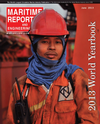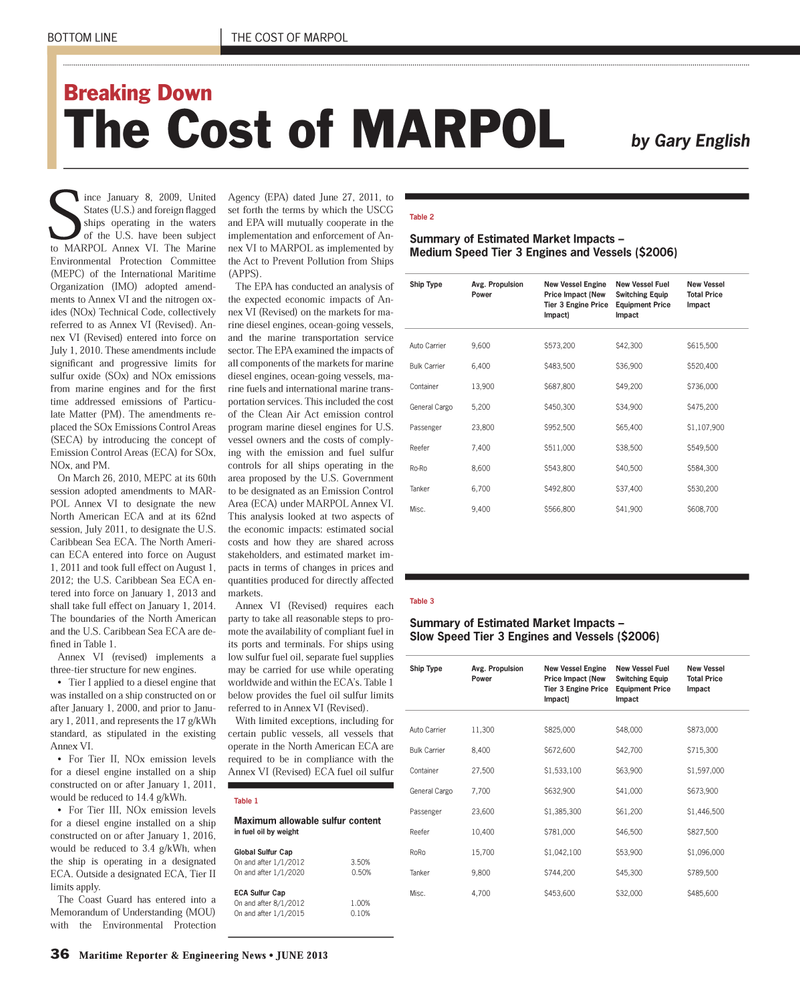
Page 36: of Maritime Reporter Magazine (June 2013)
Annual World Yearbook
Read this page in Pdf, Flash or Html5 edition of June 2013 Maritime Reporter Magazine
36 Maritime Reporter & Engineering News ? JUNE 2013 BOTTOM LINE THE COST OF MARPOL Since January 8, 2009, United States (U.S.) and foreign ß agged ships operating in the waters of the U.S. have been subject to MARPOL Annex VI. The Marine Environmental Protection Committee (MEPC) of the International Maritime Organization (IMO) adopted amend- ments to Annex VI and the nitrogen ox- ides (NOx) Technical Code, collectively referred to as Annex VI (Revised). An- nex VI (Revised) entered into force on July 1, 2010. These amendments include signiÞ cant and progressive limits for sulfur oxide (SOx) and NOx emissions from marine engines and for the Þ rst time addressed emissions of Particu-late Matter (PM). The amendments re- placed the SOx Emissions Control Areas (SECA) by introducing the concept of Emission Control Areas (ECA) for SOx, NOx, and PM. On March 26, 2010, MEPC at its 60th session adopted amendments to MAR-POL Annex VI to designate the new North American ECA and at its 62nd session, July 2011, to designate the U.S. Caribbean Sea ECA. The North Ameri- can ECA entered into force on August 1, 2011 and took full effect on August 1, 2012; the U.S. Caribbean Sea ECA en- tered into force on January 1, 2013 and shall take full effect on January 1, 2014. The boundaries of the North American and the U.S. Caribbean Sea ECA are de- Þ ned in Table 1. Annex VI (revised) implements a three-tier structure for new engines.? Tier I applied to a diesel engine that was installed on a ship constructed on or after January 1, 2000, and prior to Janu-ary 1, 2011, and represents the 17 g/kWh standard, as stipulated in the existing Annex VI. ? For Tier II, NOx emission levels for a diesel engine installed on a ship constructed on or after January 1, 2011, would be reduced to 14.4 g/kWh. ? For Tier III, NOx emission levels for a diesel engine installed on a ship constructed on or after January 1, 2016, would be reduced to 3.4 g/kWh, when the ship is operating in a designated ECA. Outside a designated ECA, Tier II limits apply. The Coast Guard has entered into a Memorandum of Understanding (MOU) with the Environmental Protection Agency (EPA) dated June 27, 2011, to set forth the terms by which the USCG and EPA will mutually cooperate in the implementation and enforcement of An- nex VI to MARPOL as implemented by the Act to Prevent Pollution from Ships (APPS).The EPA has conducted an analysis of the expected economic impacts of An- nex VI (Revised) on the markets for ma- rine diesel engines, ocean-going vessels, and the marine transportation service sector. The EPA examined the impacts of all components of the markets for marine diesel engines, ocean-going vessels, ma-rine fuels and international marine trans-portation services. This included the cost of the Clean Air Act emission control program marine diesel engines for U.S. vessel owners and the costs of comply-ing with the emission and fuel sulfur controls for all ships operating in the area proposed by the U.S. Government to be designated as an Emission Control Area (ECA) under MARPOL Annex VI. This analysis looked at two aspects of the economic impacts: estimated social costs and how they are shared across stakeholders, and estimated market im-pacts in terms of changes in prices and quantities produced for directly affected markets.Annex VI (Revised) requires each party to take all reasonable steps to pro-mote the availability of compliant fuel in its ports and terminals. For ships using low sulfur fuel oil, separate fuel supplies may be carried for use while operating worldwide and within the ECA?s. Table 1 below provides the fuel oil sulfur limits referred to in Annex VI (Revised). With limited exceptions, including for certain public vessels, all vessels that operate in the North American ECA are required to be in compliance with the Annex VI (Revised) ECA fuel oil sulfur Breaking Down The Cost of MARPOLTable 2 Summary of Estimated Market Impacts ?Medium Speed Tier 3 Engines and Vessels ($2006) Ship Type Avg. Propulsion New Vessel Engine New Vessel Fuel New Vessel Power Price Impact (New Switching Equip Total Price Tier 3 Engine Price Equipment Price Impact Impact) Impact Auto Carrier 9,600 $573,200 $42,300 $615,500 Bulk Carrier 6,400 $483,500 $36,900 $520,400 Container 13,900 $687,800 $49,200 $736,000 General Cargo 5,200 $450,300 $34,900 $475,200 Passenger 23,800 $952,500 $65,400 $1,107,900 Reefer 7,400 $511,000 $38,500 $549,500 Ro-Ro 8,600 $543,800 $40,500 $584,300 Tanker 6,700 $492,800 $37,400 $530,200 Misc. 9,400 $566,800 $41,900 $608,700 Table 3 Summary of Estimated Market Impacts ? Slow Speed Tier 3 Engines and Vessels ($2006) Ship Type Avg. Propulsion New Vessel Engine New Vessel Fuel New Vessel Power Price Impact (New Switching Equip Total Price Tier 3 Engine Price Equipment Price Impact Impact) Impact Auto Carrier 11,300 $825,000 $48,000 $873,000 Bulk Carrier 8,400 $672,600 $42,700 $715,300 Container 27,500 $1,533,100 $63,900 $1,597,000 General Cargo 7,700 $632,900 $41,000 $673,900 Passenger 23,600 $1,385,300 $61,200 $1,446,500 Reefer 10,400 $781,000 $46,500 $827,500 RoRo 15,700 $1,042,100 $53,900 $1,096,000 Tanker 9,800 $744,200 $45,300 $789,500 Misc. 4,700 $453,600 $32,000 $485,600 by Gary EnglishTable 1 Maximum allowable sulfur contentin fuel oil by weightGlobal Sulfur Cap On and after 1/1/2012 3.50% On and after 1/1/2020 0.50% ECA Sulfur CapOn and after 8/1/2012 1.00% On and after 1/1/2015 0.10% MR #6 (34-41).indd 36MR #6 (34-41).indd 365/30/2013 1:04:37 PM5/30/2013 1:04:37 PM

 35
35

 37
37
